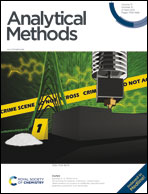An optic-fiber graphene field effect transistor biosensor for the detection of single-stranded DNA
Abstract
Herein, a graphene field effect transistor (GFET) was constructed on an optic fiber end face to develop an integrated optical/electrical double read-out biosensor, which was used to detect target single-stranded DNA (tDNA). Two isolated Au electrodes were, respectively, prepared as the drain and source at the ends of an optic fiber and coated with a graphene film to construct a field effect transistor (FET). Probe aptamers modified with fluorophore 6′-carboxy-fluorescein (6′-FAM) were immobilized on the graphene for specific capture of tDNA. Graphene oxide (GO) was introduced to quench 6′-FAM and construct a fluorescence biosensor. Thus, a dual GFET and fluorescence biosensor was integrated on the end-face of an optic fiber. Following synchronous detection by fluorescence and FET methods, results showed satisfactory sensitivity for DNA detection. Compared with conventional biosensors using a single sensing technology, these dual sensing integrated biosensors significantly improved the reliability and accuracy of DNA detection. Furthermore, this proposed technique provides both a new biosensor for single-stranded DNA detection and a strategy for designing multi-sensing integrated biosensors.



 Please wait while we load your content...
Please wait while we load your content...